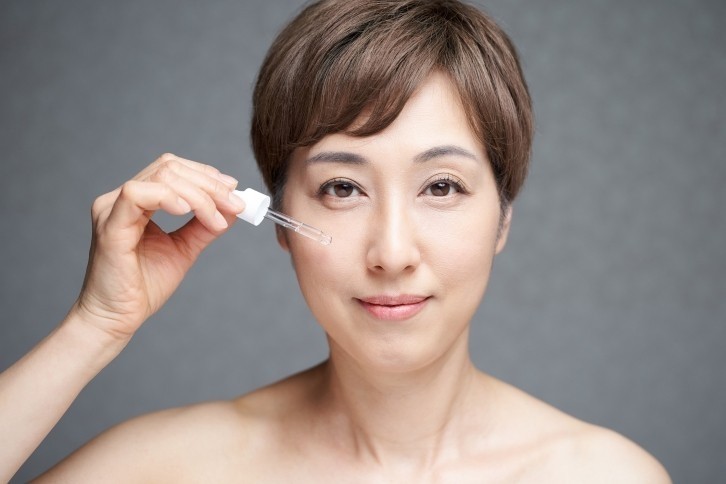Medytox study finds skin whitening and anti-wrinkle effects in anti-ageing peptides

The anti-ageing peptide studied is the cell-penetrating peptide (CPP)-conjugated soluble N-ethylmaleimide-sensitive factor attachment protein receptor (SNARE) motif of vesicle-associated membrane protein 2 (VAMP2)-patterned peptide, also known as CVP.
CVP contained seven peptides from the SNARE motifs of SNAP-25, syntaxin 4, and VAMP2, and was designed and studied by the R&D team with Medytox Inc.
In vitro studies had been conducted to assess CVP for its safety and efficacy as a potential anti-wrinkle and skin-whitening cosmetic ingredient.
Key findings
CVP treatment proved effective to reduce wrinkle activity, as it considerably reduced K+-induced norepinephrine and dopamine secretion compared to the control group by 62% and 40%, respectively.
The researchers compared the result similar to the use of botulinum neurotoxin type A (BoNT/A), a potent neurotoxin that is increasingly used for eliminating facial wrinkles.
CVP treatment also induced a skin-whitening effect by inhibiting melanin transport, and not melanin production.
This result was gathered from firstly, the lack of impact on the mRNA expression of MITF, TYR, TRP-1, and TRP-2; and secondly, while CVP reduced extracellular melanin content by 76% to 85%, it had increased intracellular melanin content in a dose-dependent manner.
It is also proved safe for use according to the OECD 439 classification. Both the MTT assay and skin irritation test showed no visible cytotoxicity effect on B16-F10 cells and human dermal fibroblasts (HDFs).
Some assessments conducted include norepinephrine and dopamine release assays, skin irritation test on 3D skin tissues, and measurements of cellular melanin content and cellular viability.
Mechanism at work
CVP treatment inhibited the release of norepinephrine and dopamine by depolarising PC-12 cells with a short pulse of high-concentration of K+, according to the researchers.
Additionally, it was proven to have similar or additional benefits to commercial products like BoNT/NA and Argireline®:
“CVP showed an effect similar to that of BoNT/A, the most potent neurotoxin. BoNT/A induces muscle paralysis by enzymatically cleaving the presynaptic SNARE protein SNAP-25 and blocking the formation of the SNARE complex, which results in a lasting inhibition of acetylcholine release in motor neurons.
“Furthermore, CVP showed a 2-fold higher inhibitory activity of norepinephrine release than Argireline®. Argireline® is patterned from the N-terminal end of the SNAP-25 protein and is a topical alternative to Botox.
“It has been scientifically proven to have Botox-like effects, such as reduced fine lines and wrinkles and improved skin elasticity and firmness by suppressing the release of these catecholamines.”
For CVP’s skin-whitening effect, due to conflicting results from the study and previous literature, the researchers said that further research on the transport mechanism induced by CVP treatment is strongly recommended.
“In this study, CVP did not exert an inhibitory effect on melanin production; however, it may induce a whitening effect by inhibiting melanin transport.
“[However], based on our recent understanding of skin melanogenesis, the binding of VAMP2 to Rab3A was displaced by CVP, which might be responsible for inhibiting melanin-containing vesicle fusion with the cell membrane, melanin transport, and transfer to keratinocytes.”
Aside from the aforementioned, the researchers recommended for further studies to be done to explore the underlying molecular mechanism of CVP’s anti-wrinkle effects, and a series of in vivo trials to determine its safety and effectiveness on human skin.
“CVP demonstrated the ability to inhibit melanin transfer to keratinocytes and neurotransmitters release such as norepinephrine and dopamine, proving promise as a cosmetic ingredient and an antiaging agent,” they concluded.
Source: Journal of Cosmetic Dermatology
“Potential role of the cell-penetrating peptide-conjugated soluble N-ethylmaleimide-sensitive factor attachment protein receptor motif of vesicle-associated membrane protein 2-patterned peptide in novel cosmeceutical skin product development”
Authors: Lee, H.J, et al.
DOI: 10.1111/jocd.15984
![ATTIA is doing its best to challenge the proposed classification of tea tree oil as a reproductive toxin. [Getty Images]](/var/wrbm_gb_food_pharma/storage/images/_aliases/wrbm_medium/publications/cosmetics/cosmeticsdesign-asia.com/headlines/regulation-safety/tea-tree-oil-regulation-challenge-against-reprotoxin-classification-is-under-control-attia-president/16769894-1-eng-GB/Tea-tree-oil-regulation-Challenge-against-reprotoxin-classification-is-under-control-ATTIA-President.jpg)
![Top five stories trending on our socials featuring La Prairie’ daigou woes, Aveda’s Vietnam potential, and more. [La Prairie]](/var/wrbm_gb_food_pharma/storage/images/_aliases/wrbm_medium/publications/cosmetics/cosmeticsdesign-asia.com/headlines/market-trends/hot-topics-top-five-beauty-stories-trending-on-our-socials/16769711-1-eng-GB/Hot-topics-Top-five-beauty-stories-trending-on-our-socials.jpg)







![[Getty Images]](/var/wrbm_gb_food_pharma/storage/images/_aliases/wrbm_tiny/publications/cosmetics/cosmeticsdesign-asia.com/china/china-focus-latest-developments-in-china-s-booming-beauty-market22/17370102-1-eng-GB/China-focus-Latest-developments-in-China-s-booming-beauty-market.jpg)
![YSL's LoveShine launch has sparked a demand surge in Japan. [YSL]](/var/wrbm_gb_food_pharma/storage/images/_aliases/wrbm_tiny/publications/cosmetics/cosmeticsdesign-asia.com/article/2024/04/24/ysl-loveshine-launch-propels-lip-gloss-sales-to-record-highs-in-japan-since-2020/17372064-1-eng-GB/YSL-LoveShine-launch-propels-lip-gloss-sales-to-record-highs-in-Japan-since-2020.jpg)
![There is significant scope for innovation and new launches in the hair repair sector, especially in soaring markets such as China. [Getty Images]](/var/wrbm_gb_food_pharma/storage/images/_aliases/wrbm_tiny/publications/cosmetics/cosmeticsdesign-asia.com/article/2024/04/24/croda-zeroes-in-on-hair-repair-solutions-as-damage-hair-concerns-surge-in-markets-like-china/17362731-1-eng-GB/Croda-zeroes-in-on-hair-repair-solutions-as-damage-hair-concerns-surge-in-markets-like-China.jpg)



![Lubrizol has extended its partnership with C-beauty major PROYA. [PROYA]](/var/wrbm_gb_food_pharma/storage/images/_aliases/wrbm_tiny/publications/cosmetics/cosmeticsdesign-asia.com/headlines/brand-innovation/lubrizol-bullish-on-potential-of-c-beauty-growth-potential/17362515-1-eng-GB/Lubrizol-bullish-on-potential-of-C-beauty-growth-potential.jpg)


